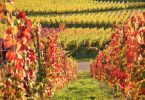The Wolf Post offers a professional service with free access, without subscription.
For this reason, a donation would also be a sign of appreciation for our work.
If in the second half of the nineteenth century European viticulture had to face the problem of phylloxera, today, and in the next few years, it will have to face a new obstacle: climate change.
A problem that requires common policies on a global level.
To understand how the national wine sector is analyzing and evaluating the first important signs of climate change, we asked the opinion of the oenologist Paolo Peira, who illustrates his experience.

© Paolo Peira Enologo
Climate change has significantly altered important areas of our planet. According to your professional experience, are these changes already taking place in Italy too?
There is no doubt that global warming has also been affecting viticulture in Italy for years. The sugar concentrations of the grapes in recent years have seen a substantial increase compared to the past and, above all, the acidity has significantly lowered with the microbiological consequences that we know well in the cellar. It is therefore necessary to understand these phenomena in order to undertake the most appropriate strategies.
Are there any interventions, including preventive ones, that it is convenient to adopt to start compensating for these changes in the climate?
I believe that the strategy to be adopted for the future, even if in the long term, will be to design new vineyards with medium-long cycle varieties, late varieties so as to overcome the warmer months while the vine is still in a less delicate stage. Even the grafts holders will have to be different from those we have used in the last twenty years, often too little vigorous.

© Paolo Peira Enologo
In some countries of Northern Europe (Denmark and Sweden), albeit in minimal quantities, they have begun to produce wine. Studies speculate that in 50 years the climate of these countries will be at the level of Northern France. What do you think of these studies and, in his opinion, could they become the new frontiers of wine in Europe?
It is objectively true, even the south of England (Kent and Sussex), which until a few years ago only produced sparkling wines, is currently moving to late varieties, such as Cabernet Sauvignon, albeit with mixed results.

© Paolo Peira Enologo
As for the Italian situation, are you aware of the planning or construction of new plants at heights above sea level which were unthinkable until “yesterday”? How do you hypothesize this change and what will be the difficulties of this oenological “readjustment”?
The vine is a rustic, versatile plant that adapts to almost all environments, in the appropriate latitudes. With global warming, the vineyards most at risk will be the coastal ones, sometimes grown on poor soils. Obviously, a cultivation of this type will be unthinkable without resorting to irrigation.
If anything, the real problem of the relocation of the vineyards will be that of the possible modification of the production areas of wines with denomination of origin.








